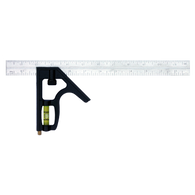Measuring & Squares
Construction Measuring Tools
We have all heard the old saying measure twice cut once! But how good is your measurement?
If you make your living in the construction, fabrication or services industry you understand the importance of measuring both from accuracy and repeatability on the job. You understand the difference between a box store measuring tool and a professional grade tool. At Industrial Tool Supply, we understand your position and were careful to select only the top-quality manufacturers for our measuring tools. We have put some helpful advice together below that we hope will help you in selecting the right measuring tool for your work.
Selecting a Good Tape Measure
Did you know that a tape measure is the single most used tool on a job site? It’s true because almost everything to be constructed or fabricated needs to be measured before the work is started. That is why a tape measure needs to be accurate, durable, and easy to use.
So what should you look for in a tape measure? Think about the use and abuse a tape measure takes and you start to understand what separates a low-grade tool from a quality one.
- The Quality of the Blade: The blade is the actual measuring tape that comes out of the case and has the measurement markings on it. A blade is also the first thing that wears out on a tape measure. A good blade should be able to resist scratching and abrasion from both the opening and retracting of the blade as well as the abuse it will take when exposed. Cheaper tape measures tend to scratch easily or get misaligned leading to a tape measure that gets caught up and won’t extend or retract.
- The Tang: This is the little metal hook at the end of the tape. Most tape measures have a right-angle tang that is riveted to the tape. The rivet should be tight, however; in fact, it should have a small amount of back and forth movement so that when doing pull measurements, the reading is accurate. You want to avoid a large or oversized tang as it will be clumsy and get caught on everything.
- The Stand-Out: This is the distance a blade can be extended unsupported from the case before it collapses. A wider blade usually provides for a longer stand out length. Typically a good width range is between a ¾” to 1-¼”. Thinner blades tend to collapse easily and wider widths just become bulky.
- Blade Length: The most common tape measure lengths are 12, 16, 25, 30, and 35 feet. A 25’ tape is a solid tape measure to buy because it’s not uncommon for a room in a house or interior hallway to have a wall longer than 16’. Unless your work deals with longer lengths a 25’ unit should work well.
- Accessories & Features: There are also features that make a tape measure easier and more comfortable to use, such as a belt clip or a blade locking mechanism. Look for units that have coatings to protect the blade from scratches and that lock out dust and debris so that the blade may function smoothly during operation. Also, look for the construction of the case to see if it will survive the day in day out abuse from being dropped or getting wet from the rain.
Digital Angle Locators
Determining angles to make the correct cuts can be tedious and sometimes frustrating especially transcribing the angle information correctly. That’s why digital angle locators were developed. While there are several styles each with a long list of features, the concept is simple. They were developed to save you time in determining angles and make transferring the data easy so that you’re more productive. A digital angle locator is simple to use. Start by turning on the LCD screen which will display the angle and math functions, then unfold the arms until they are completely extended. Then line one arm against the side of one object as a reference angle and position the unit so that the opposite arm is flush with the other object thus having one arm on each surface. The unit will display the angle on the screen. You may also use an additional function to transpose the angle you need to cut. The automatic backlight illuminates the LCD screen in low light conditions. This digital angle locator can measure in absolute or relative measurements for determining the exact angle or the difference between two angles.
There are several styles and types of digital angle locators including:
- Digital Magnetic Level & Angle Locator with Dot Laser
- Professional Magnetic Digital Angle Locator 3 Button with V-Groove and Level Vial
- Professional Magnetic Digital Angle Locator 3 Button with V-Groove
- Professional Magnetic Digital Angle Locator 2 Button
- Magnetic Digital Angle Locator
- Digital Angle Locator & Ruler
Aluminum Rulers
In today’s digital computer age why would someone buy an aluminum ruler to measure? The answer is, effective, good quality tools never go out of style. An aluminum ruler has been chosen by carpenters, construction workers, and industrial craftsmen for decades. Rulers made out of aluminum have many advantages. They won’t rust like steel, they are lightweight, and they are rigid, so they can be used as a straight edge. Further, because of their durability they won’t warp or shrink thus providing consistent and accurate measurements. Industrial Tool Supply offers a wide range of aluminum rulers in sizes and styles to make your work easier and more accurate.
We Stock: Easy-Read Aluminum, Aluminum English - 24", 36", 48", & 72", Aluminum English/Metric, Aluminum Straight - 18", 24", 36", 48", 60", 72", & 96, Aluminum Rule- 12", 18", & 24"and Aluminum Cutting rulers.
Measuring Wheel
Measuring Wheels (sometimes called surveyor's wheel) are measuring devices that employ a wheel that rolls along the ground. Each revolution of the wheel measures a specific distance, such as a yard, meter etc. Combine the counting revolutions with a mechanical device attached to the wheel and you can measure the distance directly.
Measuring Wheels provide good accuracy on a smooth surface, such as pavement but on rough terrain, wheel slippage and bouncing can reduce the accuracy. Soft sandy or muddy soil can also affect the accuracy of the wheel as well. It is a good idea to map out your run before collecting data or to keep track of any object on the path that can influence the accuracy of the distance measured and make accurate adjustments as needed.
Industrial Tool Supply offers two measuring wheels. We offer the 1m Circ. (31.75 cm Dia.) Metric Structo-Cast® Measuring Wheel as well as the 3-Foot Circ. (12.5" Dia.) Structo-Cast® Measuring Wheel. If you need assistance with selecting the right measuring tool for the job, contact us, and we will be happy to assist you.

